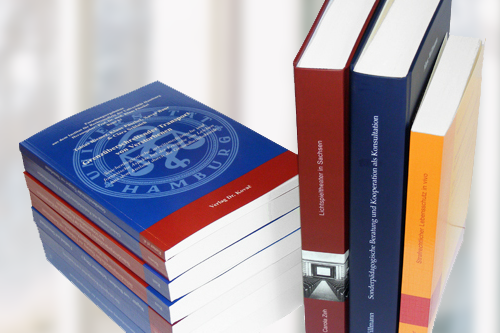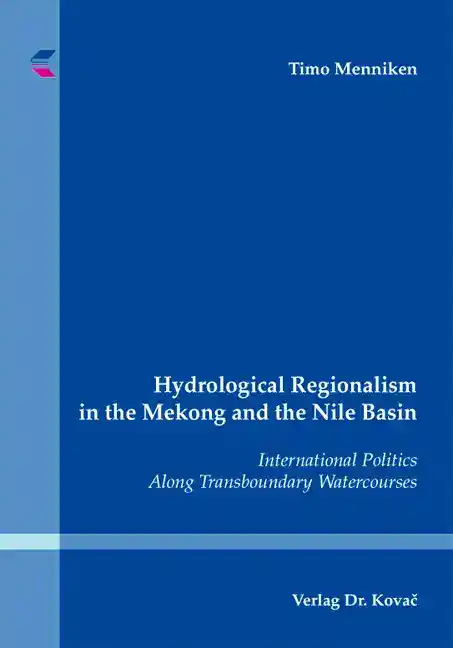Timo MennikenHydrological Regionalism in the Mekong and the Nile Basin
International Politics Along Transboundary Watercourses
Schriften zur internationalen Politik, Band 27
Hamburg 2010, 282 Seiten
ISBN 978-3-8300-4901-2 (Print) |ISBN 978-3-339-04901-8 (eBook)
Zum Inhalt
As bipolarism was dissolving, in the 1990s, the perceived threat of nuclear war decreased, while the demand for a redefinition, or rather expansion of the term and comprehension of international security has increased. The concept of “ecological vulnerability” is a brainchild of this process and has significantly influenced the post-Cold War security debate.
According to this concept, the security risks deriving from ecologically generated instability were subject to intensive debate and examination in the early 1990s, triggering the evolution of research in environmental conflict. One seminal study concluded that the alleged nexus between environmental risk and the vulnerability of international security indeed exists, but is bound to a number of causal relations in its actual appearance. In the face of an increasing world population with growing per capita demands, however, future security risks resulting from scarce resources and ecological imbalances are still very likely to appear. Among the array of renewable resources, water has been repeatedly named as the most probable source of future violent interstate conflict. There are several reasons:
Water can be renewed but not substituted. Water is the basis for life and an obstacle to development. Approximately 20 percent of the world population does not have access to safe water, twice this amount lacks basic sanitation. Water-borne diseases and deaths account for 80 percent of all diseases and 35 percent of all deaths in developing countries.
Water ignores political boundaries, eludes institutional allocations and defies legal generalizations. Numerous studies confirm a global trend of growing demand, depleting ground- water tables and increasing climate variability that reduces the availability of local water via increased number of and more intense floods and droughts. Notwithstanding the contested water-war hypothesis, which will be discussed extensively, linkages between water scarcity, poverty and political instability are evident in many cases and prove that water is a “dilemma resource”.
While in the past most of these events have taken place at a (sub-)national level, transboundary river basins are considered to be the conflict hotspots of the future. Two hundred and sixty-three international rivers have been identified, covering 45 percent of the global land mass, hosting over 40 percent of the world population. One hundred and forty-five countries lie within such a zone, of them with more than 95 percent of their respective territory. Twenty international watercourses (including five lakes) flow through five or more countries. Some of these rivers have been and still are subject to multilateral cooperation, reconciling the demands and expectations of all parties – typically in regions with a high degree of political institutional-ization and advanced regional cooperation in other fields – for example, the Rhine and the Danube rivers.
Most transboundary rivers drain regions characterized by a low level of economic development, fragile arrangement of institutions, parlous political power equation, asymetrical power distribution, subliminal animosities or even open enmities. Etymologically, the word river, riparian and rival all have the same roots, which already indicates an inherently precarious dimension to the sharing of freshwater resources. The Jordan Basin constitutes the most famous example for such riparian rivalry. The hydropolitical structure along a number of other rivers is equally delicate. Referring to the aforementioned expansion of the concept of international security, for Barry Buzan, among others, it is “not difficult to imagine the issue of allocations of water along rivers such as the Nile, the Mekong and the Indus becoming causes for the use of military force”.
In spite of this seemingly unanimous finding, recent research reveals a major gap between theoretical argument and empirical evidence. While case studies as well as global surveys continously convey the impression that water will be the source of conflict in the 21st century, more data-based aggregate analyses point to the opposite direction: Water as a transboundary resource has much more commonly been subject to cooperation than hitherto assumed. In fact, “cooperative events” over transboundary water resources by far outnumbered incidents of conflict. This empirical finding is supported by the lasting absence of a modern water war. Have the scenarios of threat been over-rated? Is water as a transboundary resource less prone to conflict and more susceptible to cooperation than commonly claimed? Or is the era of interstate water wars yet to come, as analyses led by the population growth scenario would argue?
Against the backdrop of these questions and considering the empirical evidence presented, this study wants to flipside the prevailing hypothesis, claiming that water will not, or at least not necessarily become the main source of resource conflict in the 21st century. Rather, I will argue that transboundary water resources can induce conflict as well cooperation, and lead to both situations frequently, and often concurrently in juxtaposition. The assumed concomitance of conflict and cooperation underlines the importance of fresh research that avoids the loaded water war scenario as an axiom for analysis.
A reasonable research question in the study of Hydropolitics, applicable to existing river basins therefore asks: What are the favourable conditions for avoiding conflict and generating cooperation over water in transboundary river basins?
With such a focus and acknowledging the concurrent existence of conflict and cooperation within the same river basin, the study of international Hydropolitics can be grasped as a matter of “Hydrological Regionalism”.
Schlagworte
ConflictsCooperationsEnvironmentInternationale BeziehungenInternational RelationsKonflikteKooperationMekong RiverNil RiverOstafrikaPolitikwissenschaftResourcesRessourcenSüdostasienUmweltWasserWaterIhr Werk im Verlag Dr. Kovač

Möchten Sie Ihre wissenschaftliche Arbeit publizieren? Erfahren Sie mehr über unsere günstigen Konditionen und unseren Service für Autorinnen und Autoren.
